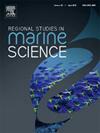高米山湿地表层沉积物中稀土元素的分布和迁移性
IF 2.1
4区 环境科学与生态学
Q3 ECOLOGY
引用次数: 0
摘要
稀土元素 (REE) 是一种新出现的环境污染物,对生态系统健康构成威胁。它们在沉积物中的积累和可能释放到水体中的情况会引起人们的关注。了解影响稀土元素流动性的因素至关重要。此外,我们对 REEs 在湿地生态系统中的风险和发生率的了解还不够。本研究调查了不同氧化还原条件(Eh)下 REE 从沉积物中的释放情况。使用光阳极(Ti/TiO2)和阴极(石墨)调节了不同的氧化还原电位值。此外,为了识别 REEs 与其他参数之间的关系,还采用了皮尔逊相关性(PC)。结果表明,Eh 值的增加最初会增强 REE 的迁移率(直到 300 mV 左右),Eh 值越高迁移率越低。在所研究的 REEs 中,镧 (La)、铈 (Ce) 和钆 (Gd) 在水中的释放潜力最大,测量浓度分别达到 199.4、93.1 和 31.2 µg/L。此外,根据若干生态地球化学风险评估指数,研究区域的沉积物被归类为轻度污染。统计分析显示,Eh 通过影响 pH 值、盐度和铁锰(Fe-Mn)化学性质的关联变化,间接影响了 REE 的流动性,而 pH 值、盐度和铁锰(Fe-Mn)化学性质的关联变化又反过来影响了 REE 的溶解性和从沉积物中的释放。本文章由计算机程序翻译,如有差异,请以英文原文为准。
Distribution, and mobility of rare earth elements in surface sediment of Gomishan Wetland
Rare earth elements (REEs) are emerging environmental contaminants that pose a threat to ecosystem health. Their accumulation in sediments and potential release into the water column can raise concerns. Understanding the factors influencing REE mobility is crucial. Furthermore, our knowledge of the risk and occurrence of REEs in wetland ecosystems is inadequate. This study investigated REE release from sediments under varying redox conditions (Eh). The different redox potential values were adjusted using a photoanode (Ti/TiO2) and a cathode (graphite). Also, to recognize the relationship between REEs and other parameters, Pearson correlation (PC) was employed. Results showed that increasing Eh initially enhanced REE mobility (until around 300 mV), followed by a decrease at higher Eh values. Among the studied REEs, lanthanum (La), cerium (Ce), and gadolinium (Gd) exhibited the highest release potential into water, with measured concentrations reaching 199.4, 93.1, and 31.2 µg/L, respectively. Moreover, according to several eco-geochemical risk assessment indices, the sediment of the study area was classified as minimal contamination. Statistical analyses revealed that Eh indirectly affects REE mobility by influencing linked changes in pH, salinity, and iron-manganese (Fe-Mn) chemistry, which in turn impacts REE solubility and release from sediments.
求助全文
通过发布文献求助,成功后即可免费获取论文全文。
去求助
来源期刊

Regional Studies in Marine Science
Agricultural and Biological Sciences-Ecology, Evolution, Behavior and Systematics
CiteScore
3.90
自引率
4.80%
发文量
336
审稿时长
69 days
期刊介绍:
REGIONAL STUDIES IN MARINE SCIENCE will publish scientifically sound papers on regional aspects of maritime and marine resources in estuaries, coastal zones, continental shelf, the seas and oceans.
 求助内容:
求助内容: 应助结果提醒方式:
应助结果提醒方式:


